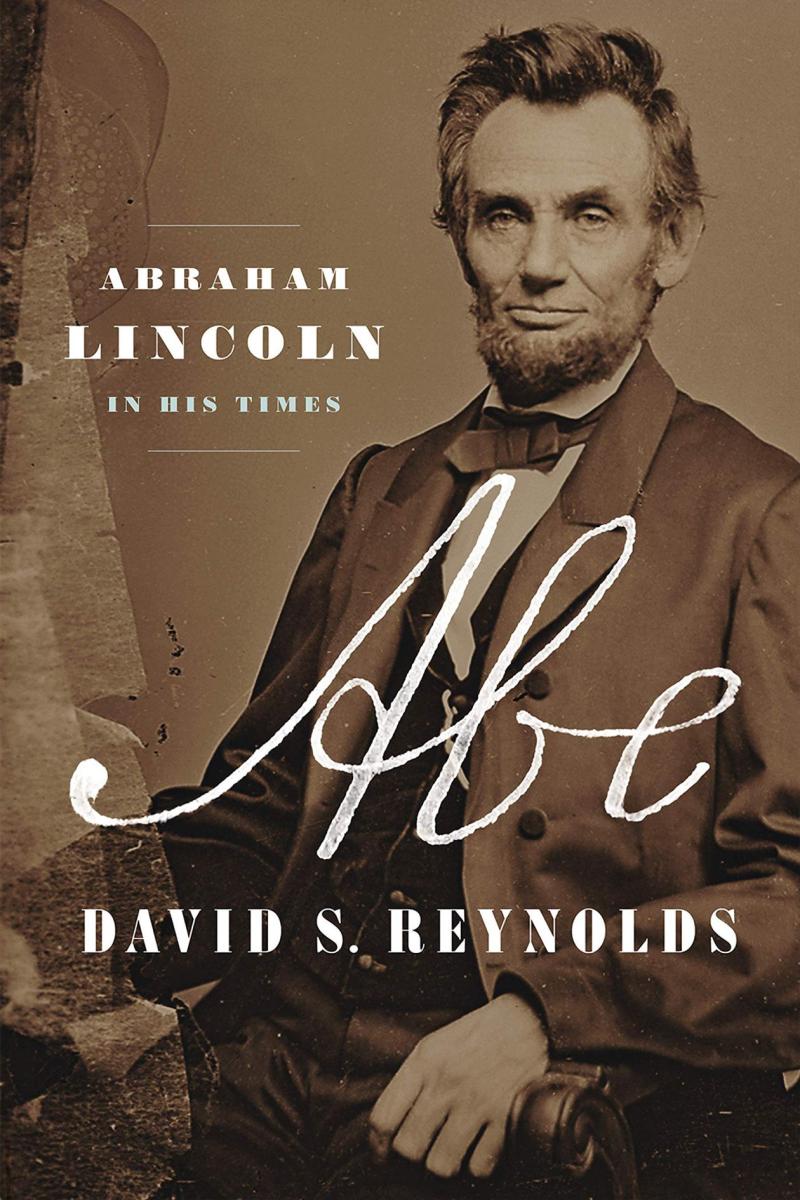‘Abe: Abraham Lincoln in His Times’ Review: Unruly Genius
By: By Gordon S. Wood



Some 16,000 books have been written about Abraham Lincoln—more than any other historical figure except Jesus. But there has never been one like this one by David S. Reynolds. The author, a literary scholar and historian at the Graduate Center of the City University of New York, has written a marvelous cultural biography that captures Lincoln in all his historical fullness. Mr. Reynolds is a distinguished cultural historian of antebellum America. Among his many books are cultural biographies of Walt Whitman and John Brown and an earlier work, “Beneath the American Renaissance,” which prepared the way for his unusual approach to biography—stunningly revealed in this life of Lincoln.
Lincoln, like Whitman and Brown, was a product of his times; and those times were wild. Whatever we might think about the divisiveness, partisanship and violence of our own era, it is nothing compared to antebellum America. Government in the first half of the 19th century was weak and unstructured, and established institutions were few and far between. The economy was diffuse and unmanageable: Thousands of different kinds of paper-money notes flew about, and risk-taking and bankruptcies were everywhere; even some states went bankrupt. This was a rough-and-tumble world, and duels, rioting and mobbing were commonplace. Alcohol flowed freely, and Americans were drinking more per capita than nearly all other nations, which provoked desperate temperance movements. Fistfights, knifings and other explosions of violence seemed to be ordinary affairs, taking place even in state legislatures and the Congress. Public rhetoric was abrasive and harsh, and zany humor and sensationalism flourished in the popular press; people were especially eager to read lurid reports of suicides. The nervous nation was coming apart, torn by sectional conflict and the struggle over slavery.
This was the disordered and unruly world Lincoln experienced. The future president was born in 1809, and possessed a natural intelligence, an easygoing temperament, an incredible memory and a sense of “innate fairness.” He became unusually tall and strong, which was helpful in the brawling world in which he grew up. But everything else about him he absorbed and adapted from his environment. Far from distancing himself from the wild world of antebellum America, Lincoln, says Mr. Reynolds, “was thoroughly immersed in it.” After he assumed the presidency, he was able to redefine democracy for his fellow Americans “precisely because he had experienced culture in all its dimensions—from high to low, sacred to profane, conservative to radical, sentimental to subversive.”
Much of Lincoln’s greatness, writes Mr. Reynolds, came from his ability to tap into this culture. He was able to respond thoughtfully to the teeming chaos of antebellum America. Lincoln was less a self-made man than an America-made man. He told his law partner, William Herndon, “Conditions make the man and not man the conditions.” But, according to Herndon, Lincoln also “believed firmly in the power of human effort to modify the environments which surround us.” Indeed, his capacity to shape the world around him was crucial to his life and to the life of the nation.
Like any good biographer, Mr. Reynolds takes us through the important events of Lincoln’s life. But unlike previous biographers, Mr. Reynolds spends an extraordinary amount of time presenting his cultural context. In effect, his biography becomes less a narrative of Lincoln’s life than an explanation of his genius. We come to understand fully why Lincoln did what he did, and why he did it when he did it.
Faced with the raw energies of frontier culture, Lincoln developed the ability to tame its wild forces, which accounts for his later measured responses to the uncontrollable social and cultural phenomena of antebellum America. Amid the chaos and passions of that world, Lincoln was always prepared to take a middling course and to avoid fanaticism. “He could take his place securely in the center,” says Mr. Reynolds, “because he had a genuine understanding of both antislavery and proslavery extremists that led him to see that radical militancy could, if carried through, destroy the Union.” Even his heritage was a balance of extremes. With Puritan ancestors in Massachusetts Bay, and Virginia roots on both sides, “Lincoln inherited both the code of honor associated with Cavalier culture and the moral sense attributed to bygone Puritanism.” He ended up in the center of Illinois, which like the nation was divided into antislavery northern and proslavery southern sections.
Although Lincoln had only one year of formal schooling, he early on wanted to make something of himself and had his eyes on a profession. Lincoln chose law, despite its adversarial nature; he favored negotiating between conflicting points of view rather than litigating disputes. Because lawyers were widely mistrusted, Lincoln put great emphasis on honesty, and he was known to return fees if he thought them unfair. He wanted to bring people together and corral the dizzying cultural conditions that were driving people apart. Everywhere he displayed an openness to the world, so much so that Emerson declared he “draws equally all classes, all the extremes of society, till we say the very dogs believe in him.”
As a member of the Illinois state legislature, Lincoln used his genial good nature to draw both sections of the state toward the center and to foster unity. When he served his one term in the House of Representatives, he became a skilled mediator in discussions over slavery. But Lincoln had no stomach for slavery, and while in Washington he tried to get a bill passed that called for the gradual emancipation of slaves in the District of Columbia. In politics he used his unusual face and his gangling awkwardness to great effect; they played into the popular culture’s fascination with the bizarre and the grotesque. Because he was a member of the Whig Party, usually dubbed “aristocrats” or “ruffled-shirt gentry,” he often posed as the humble backwoodsman for political effect. This anticipated the rail-splitter image his supporters invoked at the 1860 convention that nominated him for president.
Lincoln often responded to fleeting cultural events and circumstances, particular events and circumstances largely forgotten by later generations; indeed, most of these ephemeral cultural phenomena rarely appear in modern biographies of Lincoln. Because Mr. Reynolds knows so much about this forgotten culture of antebellum America—both the high and low parts of it—he is able to recover the often peculiar and evanescent incidents and conditions that influenced Lincoln’s actions and attitudes.
Thus Lincoln’s fabled jesting and storytelling can best be explained within the context of the coarse and smutty humor of the carnival culture of the frontier world in which he grew up. Lincoln, like many other Americans, feasted on the violent and bizarre backwoods humor featured in the immensely popular Davy Crockett almanacs and in the columns of William T. Porter’s sporting journal, the Spirit of the Times. He loved telling jokes, including dirty and scatological ones, but he generally used his jokes and stories to make a point.
During the late 1840s, the territorial acquisitions coming out of the Mexican War, which Lincoln opposed, reignited the problem of slavery in the West. The Compromise of 1850, among other things, left the newly acquired territories of New Mexico and Arizona open to slavery. But this was just a foreboding of what was to come in 1854. The Kansas-Nebraska Act in that year aroused Lincoln as nothing before ever had: The act permitted the settlers in those territories to exercise their popular sovereignty and establish slavery if they wished. Stephen A. Douglas, Democratic senator from Illinois, had engineered the act and became its principal defender. Lincoln, who had always hated slavery, now emerged as a notable opponent of Douglas and of the South’s efforts to extend slavery into the West.
But Lincoln had to be careful. The people of Illinois did not like slavery, but they weren’t abolitionists, and they did not want Blacks in their state. Lincoln became radical, but not too radical. To explain Lincoln’s difficult position, Mr. Reynolds invokes the famous tightrope performer of the 1850s, Charles Blondin, who crossed Niagara Falls on a rope with his agent on his back. Many people at the time compared Lincoln to Blondin, because the politician tried to remain centered between radicals and conservatives on slavery and had to lean sometimes left and sometimes right to keep his balance. Lincoln himself found in the tightrope performer a symbol for his centrist position on important issues, especially on slavery. This popular cultural character was important to both Lincoln and his fellow citizens, yet the major biographies of Lincoln don’t mention Blondin. Using popular culture in this way, to fill out the context surrounding Lincoln, is what makes Mr. Reynolds’s biography so different and so compelling.
He had astute political operators supporting him, and his nomination as the Republican Party’s candidate for the presidency in Chicago in 1860 was not as surprising as many later observers have thought. Although the Democrats and southerners called him “a canting, ill-bred, indecent old man,” whose “want of all dignity must disgust all Americans,” Lincoln had a particular appeal to “Young America” and the b’hoys, or Bowery Boys—working-class butchers, wagon drivers, day laborers and so on—the very people Whitman had put at the heart of his democratic “Leaves of Grass.”
Mr. Reynolds takes us through Lincoln’s presidency, during which he had to use all his Blondin-like talents to guide the country gradually toward emancipation. His Republican Party had many accomplishments besides winning the war and freeing the slaves, and Mr. Reynolds spends some time describing its financial program, the Homestead Act, the land-grant colleges and the beginnings of conservation and land preservation.
But Mr. Reynolds never loses sight of Lincoln’s great contributions in ending slavery and fostering the importance of equality to all Americans. The author quotes Lincoln claiming that he “hated slavery . . . as much as any Abolitionist,” and he mounts a substantial amount of evidence to back up that claim. Lincoln was no racist, and was one of only a few white Americans at the time who weren’t. He welcomed Blacks like Frederick Douglass and Martin Delany to the White House and treated them as friends and equals. Douglass sometimes wavered in his attitude toward Lincoln, especially early on, but in time he became impressed “with his entire freedom from popular prejudice against the colored race”—the first great man whom Douglass had met in the United States “who in no single instance reminded me of the difference between himself and myself, of the difference of color.”
What was perhaps most compelling about Lincoln was his generosity of spirit. He didn’t hate the southern people for their involvement with slavery. He told his northern audience, “They are just what we would be in their situation.” Where did the sympathy and compassion expressed in his Second Inaugural—“With malice toward none; with charity for all”—come from? This big, wonderful book provides the richest cultural context to explain that, and everything else, about Lincoln.
—Mr. Wood, a professor at Brown University, is the author of “Friends Divided: John Adams and Thomas Jefferson” as well as many other works. His book “Constitutionalism and the American Revolution” will be published next year.



